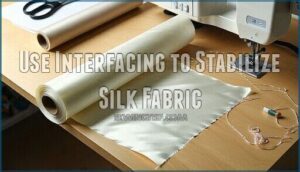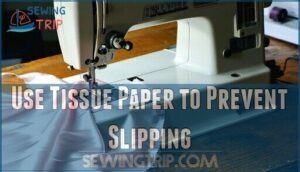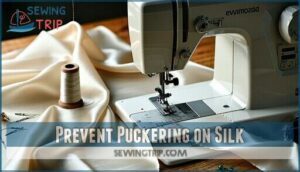This site is supported by our readers. We may earn a commission, at no cost to you, if you purchase through links.

You’ll need sharp microtex needles, fine thread, and gentle machine settings to avoid puckering. Before cutting, prewash your silk to prevent water spots later, then use pattern weights instead of pins to avoid permanent holes.
A rotary cutter works better than scissors on this shifty fabric. Keep your machine tension loose and stitch slowly—silk punishes rushed work with pulled threads and uneven seams.
The secret lies in understanding silk’s delicate nature rather than fighting it. Master these fundamentals, and you’ll discover techniques that transform frustrating fabric fights into smooth, professional results.
Table Of Contents
Key Takeaways
- Use proper tools and preparation – You’ll need sharp microtex needles (size 60-70), fine silk thread, and pattern weights instead of pins to avoid permanent holes in your expensive fabric.
- Stabilize before you sew – You should use tissue paper underneath silk while stitching and consider lightweight interfacing for structured areas to prevent slipping and distortion.
- Adjust your machine settings – You’ll want to loosen thread tension, use a 2-2.5mm stitch length, reduce presser foot pressure, and sew slowly to prevent puckering and thread pulls.
- Test everything first – You must prewash silk to prevent water marks, test fabric pens on scraps to avoid stains, and practice all techniques on remnants before cutting into your main fabric.
Essential Steps for Sewing With Silk Fabrics
Working with silk requires careful preparation to prevent costly mistakes that can ruin your expensive fabric.
You’ll need to follow specific steps for prewashing, cutting, and marking to guarantee your silk project turns out beautifully and professionally finished.
Prewash to Avoid Water Marks
Before diving into your silk sewing project, prewashing is your first line of defense against watermark prevention and silk stains.
This essential step removes manufacturing chemicals and allows the fabric to relax naturally.
- Washing delicate silks: Use gentle baby soap with cold water below 30°C
- Vinegar rinse: Add distilled white vinegar to enhance sheen and remove soap residue
- Drying techniques: Lay flat on clean towels, avoiding direct sunlight
Prewash benefits extend beyond preventing disasters during pressing.
Your silk fabric will maintain its shape throughout construction, and you’ll avoid the heartbreak of ruined garments from unexpected shrinkage.
Use Weights and a Rotary Cutter
Three simple tools transform silk cutting from wrestling match to smooth operation.
First, ditch traditional scissors for a rotary cutter – it glides through silk like butter, creating clean edges without the tugging that causes frays.
Choose a 45mm rotary cutter for straight lines and curves alike.
Pattern weights become your best friends when cutting silk.
Place them strategically along pattern edges, keeping fabric layers perfectly aligned without pin holes.
Heavy-duty weights work better than lightweight options for slippery fabrics.
Your cutting mat choice matters tremendously.
Self-healing mats protect your blade while providing the firm surface silk needs for precise cuts.
Layer tissue paper between fabric and pattern for extra stability – this stabilizing technique prevents shifting during curve cutting silk.
To further enhance workability, consider using spray stabilizer on the silk.
Weight placement tips: distribute evenly, focusing on corners and curves where fabric wants to move most.
Sharp blades are non-negotiable – even tiny nicks snag silk threads.
Replace blades frequently for consistent cutting precision.
Take your time.
Rushing leads to crooked cuts and wasted expensive fabric.
Test Fabric Pens
Not all fabric pens work well with silk sewing – some leave permanent stains or bleed through delicate fibers.
Before marking your precious silk fabric, you’ll want to test your marking tools on scraps first. This simple step prevents costly mistakes and guarantees your finished garment looks professional.
Here’s how to test fabric pens for silk compatibility:
- Mark Test Samples – Draw several lines on silk scraps using different pen types, including washable markers and air-soluble pens
- Check Mark Visibility – Ensure lines show clearly without being too bold or creating fabric distortion during application
- Perform Colorfast Testing – Wash test pieces gently, then examine for ink removal effectiveness and any remaining stains
- Assess Fabric Compatibility – Look for bleeding, fabric damage, or discoloration that might affect your project’s appearance
This testing process helps you choose the right marking tool for your specific silk type and project needs.
Avoid Permanent Marks From Pins and Needles
After checking your fabric pens, you’ll want to master pinpoint placement to avoid permanent damage.
Silk pins should only pierce seam allowances, never visible areas. Choose the finest silk pins and smallest needle size possible for your fabric weight.
Test scraps first to determine if your pinning methods leave marks. Use fabric stabilizers under delicate areas when pinning is unavoidable.
Consider marking alternatives like washable chalk or removable basting stitches instead of pins. Hand basting creates temporary holds without puncturing delicate fibers.
These silk sewing tips protect your investment while maintaining professional results.
Choose The Right Pins and Needles
Selecting proper tools transforms your silk sewing from frustrating to flawless.
Needle sharpness and pin types directly impact fabric damage, thread compatibility, and stitch quality—making smart choices essential.
- Silk pins with ultra-fine points that slip through fibers without leaving permanent holes
- Microtex needles (size 60-70) designed specifically for delicate, tightly-woven fabrics
- Sharp needles that pierce cleanly rather than pushing fibers aside
- Fresh sewing machine needles replaced for each project to guarantee peak performance
- Lightweight pins that won’t distort fabric while securing pattern pieces
Using the correct needle is vital, and you can find specialty silk needles for this purpose.
Tips for Sewing Silk
Sewing silk can feel like trying to wrangle a slippery eel, but with the right tools and techniques, you’ll get smooth, professional results.
Focus on stabilizing your fabric, picking the best needle and thread, and adjusting your machine settings to keep everything running smoothly.
Stabilize Silk Fabric With Interfacing
Working with silk fabric means taming its naturally slippery personality, and interfacing becomes your secret weapon. Think of fusible interfacing as silk’s best friend—it provides stability without stealing the spotlight.
Fusible Types offer different approaches. Knit interfacing stretches with your silk, making it perfect for drapey blouses and flowing dresses. Woven options work beautifully on structured pieces where you need crisp edges and defined shapes.
Application tips make all the difference. Test your fusible interfacing on scraps first—some silks don’t play nice with heat. Use a press cloth and moderate temperature to avoid shiny marks. The goal is fabric stabilization that feels invisible.
Smart interfacing choices prevent distortion during cutting and sewing. To guarantee proper adhesion, remember to evaluate project requirements assessment. Your silk fabric will behave like a well-trained pet instead of sliding around your workspace. This foundation step transforms frustrating silk sewing into an enjoyable experience, giving you control over this luxurious but temperamental material.
Select The Best Needle for Silk Fabric
Your needle choice can make or break your silk project.
Sharp needles, particularly Microtex types, slice through delicate fibers without causing snags or pulls.
Match needle size to fabric weight—size 60/8 for lightweight silks, 70/10 for standard weights.
Fresh needles prevent fabric damage since even slight dullness creates visible holes.
Thread compatibility matters too, so pair fine threads with appropriately sized needle eyes for smooth stitching.
It’s vital to examine sewing needle anatomy for superior results.
Choose The Right Thread for Sewing Silk Fabric
Your thread choice makes or breaks silk sewing success. Pure silk thread delivers unmatched smoothness and strength, gliding through delicate fabric without leaving marks.
Its natural elasticity matches silk’s properties perfectly. High-quality polyester works too, offering durability and color variety.
You can find a variety of silk sewing options online. Match thread weight to fabric weight—finer threads for lightweight silks, slightly heavier for thicker varieties.
Color matching prevents visible stitches from detracting from silk’s natural beauty. Different weights are available, including 100 wt. for quilting, which is ideal for quilting and other precise sewing tasks.
Adjust Sewing Machine Settings for Silk
Now that you’ve got the right thread, sewing machine settings play a huge role in silk success. Start with your stitch length at 2-2.5mm, then test on scraps—you might need to go shorter for delicate fabrics.
Your tension adjustment should be slightly looser than normal to prevent puckering. Lower your presser foot pressure so it doesn’t crush the silk fibers. Feed dogs should move fabric smoothly without tugging.
Match your needle type to fabric weight—60/8 for lightweight, 70/10 for medium-weight silk. Silk sewing machine settings aren’t one-size-fits-all. Silk sewing tension varies by fabric thickness, and silk sewing needle size affects stitch quality.
Finding the right silk sewing thread type completes the equation for professional results.
Sewing Silk: a Challenging Task
Silk’s beauty comes with a price – it’s one of the most temperamental fabrics you’ll encounter. This luxurious material seems determined to test every sewing skill you’ve developed, from the moment you unroll it until the final press.
Silk demands respect—one wrong move and your expensive fabric becomes an expensive mistake.
Sewing silk presents unique sewing challenges that can turn even seasoned seamstresses into nervous beginners. The fabric’s inherent properties create specific obstacles that require specialized sewing techniques to overcome:
- Silk slippage occurs when layers shift during cutting and stitching, creating uneven seams and misaligned pattern pieces that compromise your garment’s fit.
- Needle damage happens when dull or inappropriate needles snag silk fibers, leaving permanent holes or runs that can’t be repaired once they appear.
- Seam puckering develops when thread tension isn’t properly balanced, causing fabric distortion that creates unsightly ripples along seamlines.
Understanding these silk sewing obstacles helps you prepare mentally and practically for the journey ahead, transforming potential frustration into confident craftsmanship. For slippery silks, consider using a spray stabilizer to improve workability.
How to Sew Silk and Get Professional Results
Getting professional results when sewing silk requires the right preparation and techniques to handle this delicate fabric.
You’ll need to master specific methods that prevent common problems like puckering, slipping, and fabric damage while creating beautiful, polished garments, using the right techniques to achieve professional results.
Use Interfacing to Stabilize Silk Fabric
Think of interfacing as your silk’s best friend—it’s the steady hand that keeps delicate fabric from misbehaving.
Choose lightweight fusible interfacing or silkweight interfacing to prevent pattern distortion without adding unwanted bulk.
Fusible knit varieties work beautifully with stretchy silks, while woven interfacing suits structured pieces perfectly.
Test the adhesive quality on scraps first, ensuring proper interfacing weight matches your project.
Apply interfacing to key areas like necklines and buttonholes where silk stabilizers prove essential.
This simple step transforms tricky silk sewing into manageable, professional results.
Choose The Best Needle for Silk Fabric
After stabilizing your silk with interfacing, needle selection makes or breaks your project.
Choose Microtex or Sharp needles for silk sewing—their fine points pierce fabric cleanly without creating snags.
Match needle size to fabric weight: size 60/8 for delicate chiffons, 70/10 for standard silks.
Replace needles frequently since dull points damage silk fibers permanently, leaving visible holes that can’t be repaired, which is why frequent replacement is crucial.
Select The Right Thread for Sewing Silk Fabric
Every stitch deserves the perfect partner, and thread selection can make or break your silk masterpiece.
Quality silk thread provides unmatched strength and luster, while polyester offers durability and color variety for everyday projects.
Thread Types for Silk Sewing:
- 100-weight silk thread – Best for delicate fabrics and invisible seams
- High-quality polyester – Strong, colorfast option with excellent stretch
- 50-weight silk thread – Ideal for medium-weight silks and topstitching
- Cotton thread – Gentler on fabric but less durable than polyester
- Color matching – Place thread across fabric to find perfect blend
Sew Silk With a Straight Stitch Plate
Mastering silk sewing becomes infinitely easier when you harness the power of a straight stitch plate. This specialized throat plate transforms your sewing machine into a precision instrument, providing unwavering support for delicate silk fabric while eliminating the frustrating fabric drops that plague standard zigzag plates.
- Install a straight stitch throat plate to create a smaller needle opening that supports fine silk fabric better than standard plates
- Adjust plate alignment to guarantee your needle enters the center opening without hitting the sides during stitching
- Select straight stitch mode on your sewing machine to match the plate’s single-hole design for ideal stitch control
- Set shorter stitch length between 1.5-2mm to prevent perforation while maintaining strong seam integrity on silk fabric
- Engage needle-down function for precise pivoting and consistent thread tension when maneuvering corners and curves
The straight stitch plate’s smaller opening prevents silk from being pulled down into the machine, giving you superior stitch control. Your sewing speed can remain steady while thread tension stays consistent, creating professional results that’ll make fellow seamstresses green with envy.
Use Tissue Paper to Prevent Slipping
Precision matters when sewing silk, and nothing ruins a good mood faster than silk slipping all over the place.
Grab some tissue paper—yes, the same stuff you’d use for gift wrap—and place it under your silk fabric as you stitch.
This simple sewing aid boosts Silk Stabilization and stops fabric slipping, making your seams sharp.
After sewing, just tear the tissue away, it’s a game-changer for cutting techniques and sewing silk projects, providing a significant improvement in overall sewing silk quality.
Prevent Puckering on Silk
While tissue paper helps control slipping, preventing puckering requires adjusting your machine settings.
Loosen your needle thread tension and use a 2-2.5mm stitch length for silk fabric. A size 60/8 or 70/10 Microtex needle works best for puckering prevention.
Consider using a walking foot for better fabric feeding and seam finishing control. Place tear-away stabilizer beneath your silk for fabric stabilization during stitching. Sew slowly to maintain control – rushing creates tension issues that cause puckers.
For ironing techniques, press seams with a cool iron and press cloth, avoiding sliding motions. Test these adjustments on scraps first, using the same fabric layers you’ll sew.
With proper tension settings and stabilization methods, you’ll achieve smooth, professional seams every time. To minimize distortion, understanding sewing tips to prevent is vital for working with delicate fabrics like silk.
What to Sew With Silk Fabric
Now that you’ve mastered the technical aspects of sewing silk, you’ll want to put those skills to work on projects that showcase silk’s natural elegance.
Silk transforms simple sewing projects into luxurious masterpieces that showcase your refined skills.
Silk fabric opens up a world of sophisticated possibilities for both your wardrobe and home.
For garments, silk blouses remain timeless classics that pair beautifully with everything from business suits to weekend jeans.
When you’re ready to tackle more ambitious silk projects, consider creating silk dresses or formal gowns that highlight the fabric’s gorgeous drape.
Evening wear made from silk creates stunning silhouettes that move gracefully with your body.
Don’t overlook luxury accessories either.
Silk scarves, pocket squares, and hair accessories make perfect beginner projects that let you practice your silk sewing techniques on smaller pieces.
Beyond clothing, silk transforms home décor projects into something special.
Try crafting silk pillowcases, curtain panels, or table runners.
Each silk garment you create becomes a reflection of your growing expertise with this luxurious material.
Frequently Asked Questions (FAQs)
Is silk difficult to sew with?
You’ll find silk tricky because it’s slippery, frays fast, and shows every pinhole or stitch.
Use sharp needles, a gentle touch, and stabilizers.
Think of it as sewing on ice—patience and practice make it easier.
How do you store silk fabric properly?
Like a delicate butterfly’s wings, silk fabric needs gentle handling and protection from harm.
You’ll want to store your silk flat or loosely rolled in acid-free tissue paper, keeping it in a cool, dry place away from direct sunlight and moisture to prevent damage.
Can silk be sewn on serger machines?
You can sew silk on a serger, but use a three-thread setup to keep seams light and avoid bulk.
Go slow, use sharp needles, and test on scraps—sergers can be slippery customers with delicate fabrics.
Whats the best way to remove mistakes?
Careful cutting conquers costly corrections.
Silk doesn’t unpick well, so seam rippers damage delicate fibers.
You’ll need extra fabric for mistakes. Remove stitches gently using sharp, fine-pointed tools, working slowly to prevent pulls or runs.
How do you handle silk bias cuts?
Bias cuts require extra care since they stretch easily. Use tissue paper under fabric while cutting, hang pieces to relax, and stay-stitch curved seams immediately to prevent distortion.
Should silk garments always be lined?
Not always.
You’ll want lining for structured pieces, sheer fabrics, or garments needing durability.
Casual silk blouses or flowing dresses often look better unlined, letting the fabric drape naturally and breathe.
Conclusion
Picture yourself gliding a needle through shimmering silk, each stitch smooth and precise.
With these pro tips, sewing silk doesn’t have to be intimidating.
Use sharp tools, gentle hands, and the right settings to keep your fabric flawless.
Remember, patience is your best friend—rushing leads to snags and puckers.
As you master these techniques, you’ll find sewing silk can be just as rewarding as it’s challenging, giving your projects a truly professional finish.
- https://nancysnotions.com/want-to-learn-to-sew-with-silk/
- https://biddlesawyersilks.com/how-to-sew-silk-10-top-tips/
- https://www.seamwork.com/fabric-guides/the-ultimate-guide-to-sewing-with-silk
- https://inthefolds.com/blog/2016/12/13/the-acton-sew-along-tips-for-sewing-with-silk-or-similar
- https://www.reddit.com/r/sewing/comments/16paz1x/do_i_need_a_different_needle_for_silk/


















